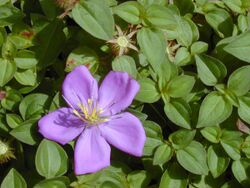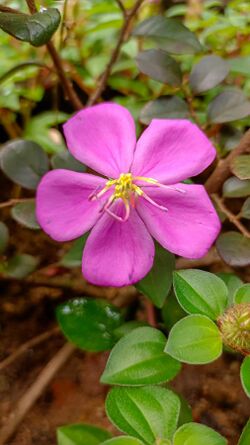Biology:Dissotis rotundifolia
| Dissotis rotundifolia | |
|---|---|

| |
| Scientific classification | |
| Kingdom: | Plantae |
| Clade: | Tracheophytes |
| Clade: | Angiosperms |
| Clade: | Eudicots |
| Clade: | Rosids |
| Order: | Myrtales |
| Family: | Melastomataceae |
| Genus: | Dissotis |
| Species: | D. rotundifolia
|
| Binomial name | |
| Dissotis rotundifolia (Sm.) Triana
| |
| Synonyms[1] | |
| |
Dissotis rotundifolia, commonly called pink lady, Spanish Shawl, or rockrose,[2] is a shrub in the family Melastomataceae that occurs in tropical Africa.[3]
Description
Dissotis rotundifolia can grow in a variety of ways, from straight up and erect to lying flat and prostrate to decumbent, meaning the branches lie flat on the ground but turn up at the ends. When the stems trail, they root where the leaf connects to the stem, called the "node". The stems are woody on lower parts of the plant and become hirsute, meaning hairy, towards the top of the plant. The branches tend to spread wide, and range from pink to a dark reddish in color.[1]
The leaves are oval shaped and three-ribbed, being 1–3 cm (0.39–1.18 in) long and 6–15 mm (0.24–0.59 in) wide.[4] They are covered with short, appressed hairs on both sides. The stalks of the leaves are as long as 1.5 cm (0.59 in), pilose, and pink.
The flowers of Dissotis rotundifolia are solitary, and the stalks of the flowers, like the leaves, are covered with tiny appressed hairs. The petals of the flower are 1.5–2 cm (0.59–0.79 in) in length and range from pink to a pale purple in color.[5]
Habitat and ecology
Dissotis rotundifolia is native to Africa, occurring naturally in central and western Africa from Sierra Leone to Zaire. It has been introduced as a ground cover and ornamental plant to other tropical areas such as Puerto Rico, Hawaii, Malaysia, and the West Indies,[6][5] and has become naturalised in some topical parts of Australia.[7] The shrub can grow anywhere in altitude from sea level to about 1,900 m (6,200 ft) above sea level.[8]
Uses
The leaves of Dissotis rotundifolia are used as a spice for sauces and as a potherb.[6] In Liberia, the plant is used as a diuretic.[9]
References
- ↑ 1.0 1.1 Umberto Quattrocchi (2012). CRC World Dictionary of Medicinal and Poisonous Plants: Common Names, Scientific Names, Eponyms, Synonyms, and Etymology. 4. CRC Press/Taylor & Francis. ISBN 9781439895702.
- ↑ Macfoy, Cyrus (2013). Medicinal Plants and Traditional Medicine in Sierra Leone. iUniverse. p. 147. ISBN 978-1-4917-0611-4. https://books.google.com/books?id=tDGGAgAAQBAJ&pg=PA147. Retrieved February 11, 2020.
- ↑ Livia Wanntorp; Louis P. Ronse De Craene (22 September 2011). Flowers on the Tree of Life. Cambridge University Press. pp. 229–232. ISBN 978-1-139-50235-1. https://books.google.com/books?id=UN3yp9pvTYYC&pg=PA229.
- ↑ John Wilkes (1820) Encyclopaedia Londinensis, Or, Universal Dictionary of Arts, Sciences, and Literature Volume 17
- ↑ 5.0 5.1 Alain H. Liogier (1982) Descriptive Flora of Puerto Rico and Adjacent Islands
- ↑ 6.0 6.1 Johannes Seidemann (2005) World Spice Plants: Economic Usage, Botany, Taxonomy
- ↑ "Dissotis rotundifolia". Centre for Australian National Biodiversity Research (CANBR), Australian Government. 2020. https://apps.lucidcentral.org/rainforest/text/entities/Dissotis_rotundifolia.htm.
- ↑ G. E. Wickens (1975) Flora of Tropical East Africa
- ↑ E. B. Shuttleworth (1878–1879). Canadian Pharmaceutical Journal. 12.
Wikidata ☰ Q15390985 entry


